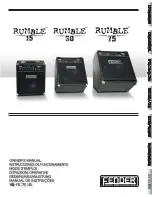
7
8. BRIGHT SWITCH
This switch brings in an extra capacitor (switch down) across the Gain control to boost the high-
mid and upper frequencies. The effect of this is dependant on the position of the Gain control –
lower settings mean that the switch is more active – higher positions mean that it is less active. A
good use of this switch is to give extra bite and clarity to muddy sounding humbucking pick-ups.
9. FAT SWITCH
This switch brings in some extra gain, and also focuses the mid range of the guitar and amp
which helps produce the “singing” tone when playing lead lines.
10. EQ and TONE controls
The TREBLE, MIDDLE, and BASS controls on this channel are of the interactive passive format
but have different characteristics than the classic VOX TB circuit that Channel 1 is based on. The
EQ is centered on different frequencies to enhance the higher gain capabilities of Channel 2.
Generally speaking the position of each control knob will influence the effect of the other two. Our
advice is to set the three controls at their midpoint positions and start from there. Experimentation
is the key to finding your tone. For starters turning the Middle control down will make the sound
more “hollow” particularly with high gain (distorted) settings, as typified on many modern heavy
rock songs. Turning the Middle up will make the tone fuller, smoother and produce a more “sing-
ing” tone. Adjust Bass & Treble to suit.
The PRESENCE control is often found on other rock oriented guitar amps. It normally functions
in the feedback circuit of the power amp to gently boost the presence frequency range (around 2
to 3kHz). This achieves the purpose of making the sound more lively and attacking, and originally
was used to compensate for dead sounding rooms and auditoria. But of course, we at VOX like
to do things a little differently than other amp companies: our Presence circuit combines the
traditional active power amp feedback circuit with a passive circuit within Channel 2’s preamp
that not only focuses the Presence boost but, by turning the control down, will introduce a high
frequency cut filter that can be used to de-fuzz the preamp distortion, making it less aggressive
and sweeter.
11. REVERB
This control regulates the amount of the on-board spring reverberation required for Channel 2
only. Please remember that the reverb is controlled ON or OFF by the footswitch as well!
12. VOLUME
This control is set at the end of the Channel 2 preamp circuit, before it goes to the FX Loop,
Reverb, and Power Amp sections. As such it governs how loud the sound generated by the
Channel 2 electronics will be. Obviously, low settings of the control will mean the amp will be
pretty quiet, and higher settings will mean total mayhem has broken out! As the total sound level
is controlled by both the Gain and Volume controls (and the Output Master, but more on this later)
you will need to balance both the level and character of the sound with both these controls.
MASTER SECTION
13. OUTPUT MASTER VOLUME
This control is what is called a Post Phase Inverter Master Volume (PPIMV) and is so called
because it operates in the power amplifier circuit between the output of the phase inverter valve
and the input of the power output valves. A great deal of the sound of a valve guitar amplifier is
actually generated by the phase inverter valve and therefore by using this type of design much of
the true power amp characteristics are retained when you use this type of Master Volume. I.e. it
keeps much of the true valve sound even at low levels of volume. In simple terms this control
regulates the actual power output produced by the power amplifier, so at lower levels it is akin to
Содержание AC100CPH
Страница 2: ......







































